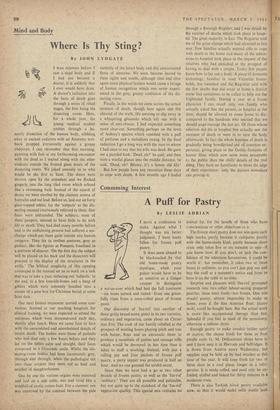Mind and Body
Where Is Thy Sting?
By JOHN LYDGATE
I WAS nineteen before I saw a 'dead body and if I had not become a doctor, it is unlikely that I ever would have done. A doctor's initiation into the facts of death goes through a series of ritual stages, the first being the dissecting room. Here, for a whole year, the young medical student
ambles through a lei- surely dissection of the human body, nibbling away at ancient cadavers with an Anatomy text- book propped irreverently against a greasy abdomen. I can remember that first morning, yawning with fear at my forthcoming encounter with the dead as I waited along with the other students outside the frosted glass doors of the dissecting room. We joked uneasily as to who would be the first to faint. The doors were thrown open by the attendant and we flocked gingerly into the long tiled room which echoed like a swimming bath. Instead of the stench of decay we were startled by the clammy aroma of formalin and red lead. Before us, laid out on forty glass-topped tables, lay the 'subjects' as the dis- secting manual courteously referred to them. Our fears were unfounded. The subjects, most of them paupers, seemed to have little to do with life or death. They had died many months before and in the embalming process had suffered a sea- change which put them quite 'outside any human category. They lay in restless postures, grey as puthice, like the figures at Pompeii, fossilised in a moment of disaster. 'On the first day the subject will be placed on his back and the dissectors will proceed to the display of the structures in the axilla.' The biblical simplicity of this opening command in the manual set us to work on a task that was to take a year, reducing our 'subjects,' in the end, to a few knuckle-bones and a heap of giblets which were solemnly bundled into a corner of a pine box for Christian burial at some later date.
Our next formal encounter carried more con- viction. Arrived at our teaching hospitals 'for clinical training, we were expected to attend the autopsies which were demonstrated each day, shortly after lunch. Here we came face to face with the unvarnished and unembalmed details of recent death. The bodies were those of patients who had died only a few hours before and they lay on the tables calm and straight, their faces composed in a Gioconda smile. Whilst the dis- secting-room bodies had been inanimately grey, dirmigh and through, when the pathologist cut into these corpses they were red as beef and smelled of slaughterhouses.
One by one the various organs were removed and laid on a side table, wet and vivid like a windfall of exotic rotten fruit. For a moment one was unnerved by the contrast between the pale austerity of the intact body and this unwarranted fiesta of intestine. We soon became inured to these sights and smells, although time and tithe again some physical feature would cause a twinge of human recognition which one never experi- enced in the grey, greasy confusion of the dis- secting room.
Finally, in the wards we came across the actual moment of death, though here again one felt cheated of the truth, life seeming, to slip away in a whispering glissando which left one with a sense of anti-climax. I had expected something more clear-cut. Something ,perhaps on the level of Aubrey's spectre which vanished with a puff of perfume and a melodious twang. In the final reduction Igo a long way with the man to whom I had once to say that his wife was dead. He gave me a puzzled look. 'Dead, eh?' he said; and then with a wistful glance into the middle distance, he said, 'Dead, eh? Blimey, it's a funny old life.'
But few people have any resources these days to cope with death. A few months ago I leafed through a Borough Register, and I was struck by the number of deaths which took place in hospi- tal. The great majority, in fact. The Registrar told me of the great change which had occurred in this way. Few families actually seemed able to cope with death in the home and many of the admis- sions to hospital took place at the request of the relatives who had panicked at the prospect of having to deal with a corpse. Today few people know how to lay out a body. A piece of domestic technology, familiar in most Victorian house- holds, has vanished and the Registrar said with the few deaths that did occur at home a district nurse had sometimes to be called to help out the frightened family. During a year as a house physician I can recall only one family who actually asked that the patient, in hospital at the time, should be allowed to come home to die; compared to the hundreds who insisted that we should stage-manage the last act. Of those whose relatives did die in hospital few actually saw the moment of death or went in to view the body afterwards. In fact the whole business of death is gradually being bowdlerised out of common ex- perience, giving place to the Gothic fantasies of horror films which now seem more acceptable to the public than the chilly details of the real thing. They have no familiarity to blunt the edge of their experience : only the doctors nowadays can provide it.






































 Previous page
Previous page